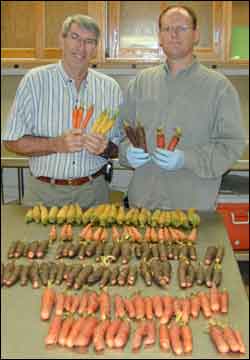Carrots of Color: Pallette of Phytochemicals Provided Through Texas Research

Dr. Leonard Pike, left, and research assistant Michael Faries sort through more than 250 bushels of red, yellow, maroon and orange carrots to prepare for this year’s breeding crop. Pike, a Texas Agricultural Experiment Station vegetable breeder, hopes to develop a variety of carrot packed with all the essential phytochemicals known to prevent human disease. (Texas Agricultural Experiment Station photo by Kathleen Phillips)
In the late 1980s, Dr. Leonard Pike stood at a roadside vegetable market in Russia and watched a produce man chop, chop, chop much like a butcher slicing deli meat. When he was finished, the thin, yellow medallions under his knife were gathered up like poker chips, weighed in a bag, and handed to the customer.
“He was cutting carrots. They sold them sliced, even back then. I thought that was fascinating,” said Pike, a horticulturist who was in Russia on a seed-collecting mission for the Texas Agricultural Experiment Station.
Besides the novelty of slicing carrots for sale, Pike was struck by the lemon yellow color of Russian carrots, cousins to the common orange varieties in the United States. Before he left that country, Pike gathered up some Russian seed to deposit in the U.S. Department of Agriculture’s world seed collection.
His selection of more than 20 years ago now may be parlayed into sliced carrots for the U.S. market within the next couple of years. Pike eventually obtained some yellow carrot seed for his own planting trials and harvested the crop about a month ago. A Texas processing company is gearing up to package that and other vegetable novelties.
In a processing room at Texas A&M University recently, Pike’s yellow yield were stacked up against maroon, red and improved orange carrots for strenuous tests to see which would make it to the next step in breeding.
“The interest now is more than the color,” said Pike, known for developing popular produce such as the 1015 onion and Beta Sweet maroon carrots. “Each of those colors indicates that a certain phytochemical is present. My goal is to get one carrot that has them all.”
Phytochemicals are naturally occurring compounds that prevent disease. Pike hopes to pack lutein, carotene, anthocyanin and lycopene into one carrot, regardless of what color — or color combination — the carrot turns out to be. Each of those compounds has been shown to ward off various diseases and improve health.
Breeding a better carrot is important, he said, because adding value to something people already eat plenty of means they could be healthier. Americans eat more than 5 pounds of carrots a year, according to the USDA’s Economic Research Service.
Deciding which carrots to keep in the breeding program is no small effort. Pike, research assistant Michael Faries and several students first washed the 250 bushels harvested from a South Texas field, sorted for conformity, tasted for flavor and finally sliced off a chunk to analyze for sugar and phytochemical content.
From that, some 80 bushels will planted by mid-April in selectively arranged cages designed around individual hives of honeybees to allow carrots to pollinate without crossing with unintended varieties.
The process will be narrowed next year, and with the luck of a good growing season, carrots could begin to show up in grocery stores in another year.
Media Contact
More Information:
http://www.tamu.eduAll latest news from the category: Agricultural and Forestry Science
Newest articles

Trotting robots reveal emergence of animal gait transitions
A four-legged robot trained with machine learning by EPFL researchers has learned to avoid falls by spontaneously switching between walking, trotting, and pronking – a milestone for roboticists as well…

Innovation promises to prevent power pole-top fires
Engineers in Australia have found a new way to make power-pole insulators resistant to fire and electrical sparking, promising to prevent dangerous pole-top fires and reduce blackouts. Pole-top fires pose…

Possible alternative to antibiotics produced by bacteria
Antibacterial substance from staphylococci discovered with new mechanism of action against natural competitors. Many bacteria produce substances to gain an advantage over competitors in their highly competitive natural environment. Researchers…





















